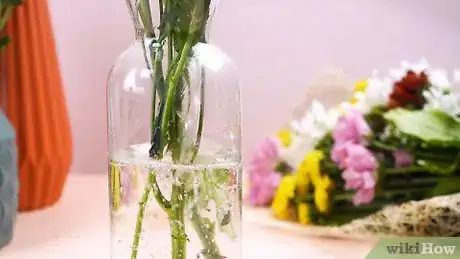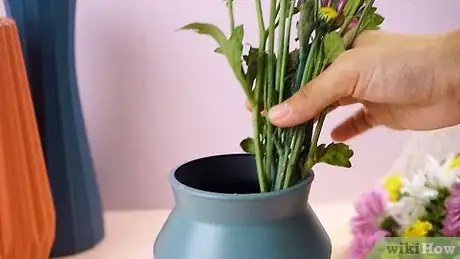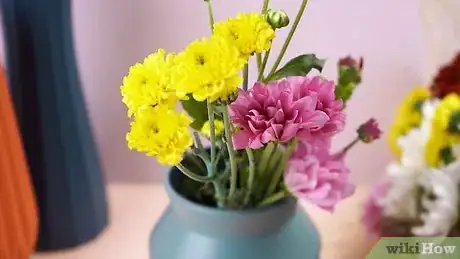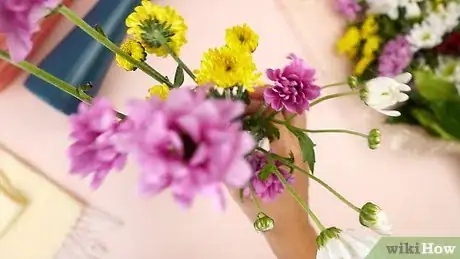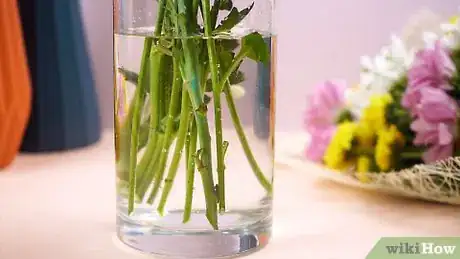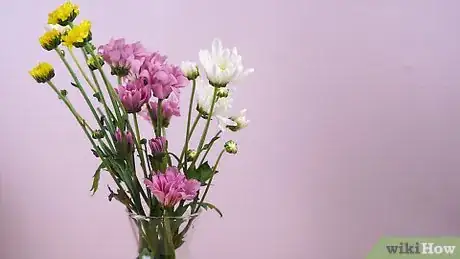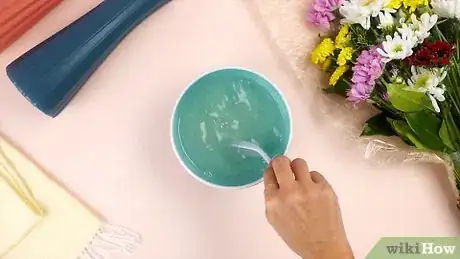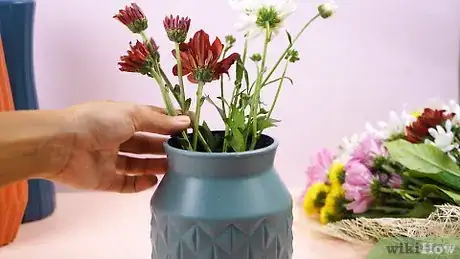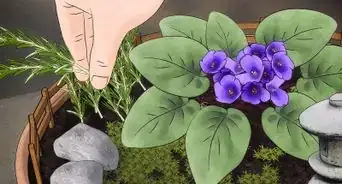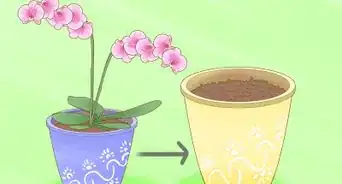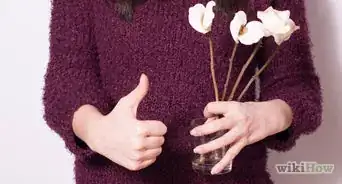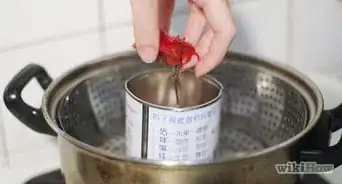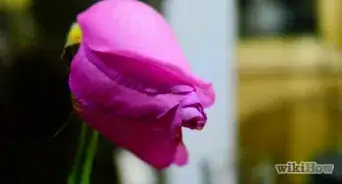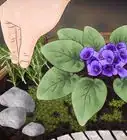This article was co-authored by Rachel Cho. Rachel Cho is a Floral Designer, Plant Specialist, and the Owner of Rachel Cho Floral Design, a floral shop based in New York City. With more than 16 years of experience, she specializes in original and impactful floral design and is known for her dexterity, innate artistry, and design sense. Rachel’s work has been featured in numerous national media outlets such as The New York Times, Harper’s Bazaar, and Huffington Post Weddings.
wikiHow marks an article as reader-approved once it receives enough positive feedback. In this case, 95% of readers who voted found the article helpful, earning it our reader-approved status.
This article has been viewed 515,174 times.
How wonderful it is when someone presents you with flowers, wrapped in paper or in a box, straight from the florist. It seems to say that "I am thinking of you" in such a warm and romantic way. Flowers show feelings, thanks, or welcoming to their recipient. Making flowers last longer will add to your enjoyment of them, so they will not wither and wilt so fast.
Steps
Using Warm Water
-
1Place flowers in warm water as soon as possible. Once the stems of flowers have been cut, you have removed their life support system.[1]
- Remove the wrapping paper, as paper can bruise the flowers and cellophane can cause them to sweat.
- When cut flowers have been left out of water for any length of time, cells start to form over the cut ends of the stems, which will prevent the stems from taking up water readily. To remove this sealed portion, snip off about 2.5cm (1") from the stem ends and then place in water preferably with preservative added, and allow the flowers to have a long drink before arranging.
-
2Fill a plastic bucket, one-third to one-half full, with warm water. Warm water should be used as flowers take up warm water more readily than cold.
- Flowers only drink through the ends of the stems and not through the sides of the stems, and for this reason, buckets should not be filled right up to the top with water, as foliage left on stems below the waterline will rot and pollute the water. This will feed bacteria and the flowers will die more quickly.
- The foliage of Marigolds, Chrysanthemums, Stock, and Daisies send off a particularly strong odor when left standing underwater over a period of time.
Advertisement -
3Take the bucket of water into the garden with you. Use a sharp pair of secateurs and cut the flower stems on an angle - a slanted cut allows a better intake of water. Remove all foliage from the lower portion of the stems which would stand under the waterline. Place the flowers immediately in the water.[2]
-
4Avoid overcrowding flowers. Allow enough air to circulate between each flower. Too many flowers crowded together in a bucket may cause the petals to become squashed and bruised. Place the bucket in a cool dark place and allow the flowers to have a long drink before being arranged. When picking short-stemmed flowers, use a smaller container.
-
5Allow flowers to have a good drink for four to five hours, preferably overnight before arranging. This step is called conditioning. It allows the stems to fill up with water and the flowers will become crisp. These flowers will last twice as long as those that have not been conditioned properly.
-
6Use a flower preservative to destroy bacteria in the water. Flower preservatives are available in garden centers or supermarkets. Another alternative is to use a cap-full of household bleach in the water. If a preservative is not used, the water needs to be changed and the stems cut on an angle daily. If a preservative is used, the stems do not require re-cutting and water needs changing only about twice a week. Flowers, like Freesias, Spray Carnations and Liliums, have lots of buds. By using a preservative in the water, it helps develop the buds to open.
- Trimming the stems slightly each time you change the water can help with longevity.
Adding Aspirin
-
1Put a cut flower in a pot or vase. Fill half the pot or vase with water.
-
2Add one tablet of aspirin.[3]
-
3Wait for 1 day. Repeat; add another tablet.
-
4Leave the flowers be after this. The aspirin will help the flowers to stay fresh for around five to nine days without putting in new aspirin pieces.
Using Homemade Plant Food
-
1Make homemade plant food. Flowers need food, water, and a clean environment. As such, their water should have a little food, like sugar, and some bleach to slow fungi and bacteria growth. Here's a basic home recipe:
- Mix together 1 quart water + 2 tablespoons lemon juice + 1 tablespoon sugar + 1/2 teaspoon bleach. Pour into the vase.[4]
-
2Trim the flower stems. This is to open the stems up to the water. Cut off the dried bottoms at an angle, the angle allowing them to take up as much water as possible.
- Trim the ends, which tend to get gummy and closed, every three or four days to keep them fresh longer.
-
3Remove leaves. Leaves left on the stems below the water level will quickly deteriorate and promote mold. Remove all leaves from the stems below the waterline.
-
4Place the trimmed flowers into the homemade plant food. Top up with water as needed.
Expert Q&A
-
QuestionWhat's the best way to cut roses?
 Rachel ChoRachel Cho is a Floral Designer, Plant Specialist, and the Owner of Rachel Cho Floral Design, a floral shop based in New York City. With more than 16 years of experience, she specializes in original and impactful floral design and is known for her dexterity, innate artistry, and design sense. Rachel’s work has been featured in numerous national media outlets such as The New York Times, Harper’s Bazaar, and Huffington Post Weddings.
Rachel ChoRachel Cho is a Floral Designer, Plant Specialist, and the Owner of Rachel Cho Floral Design, a floral shop based in New York City. With more than 16 years of experience, she specializes in original and impactful floral design and is known for her dexterity, innate artistry, and design sense. Rachel’s work has been featured in numerous national media outlets such as The New York Times, Harper’s Bazaar, and Huffington Post Weddings.
Floral Designer & Plant Specialist Use sharp shears and cut your rose stems at a 45-degree angle. This allows much more surface area for the water to be absorbed through the stem, which helps the water reach the bloom.
Use sharp shears and cut your rose stems at a 45-degree angle. This allows much more surface area for the water to be absorbed through the stem, which helps the water reach the bloom. -
QuestionCan we use paracetamol instead of aspirin?
 Community AnswerThe addition of 1 tsp of household bleach and 1 tsp of table sugar in the vase will help lengthen the flower blooms and reduce the smell of decaying foliage.
Community AnswerThe addition of 1 tsp of household bleach and 1 tsp of table sugar in the vase will help lengthen the flower blooms and reduce the smell of decaying foliage. -
QuestionHow long will it last in warm water?
 Community AnswerNot as long as cold water but make sure that it is not ice-water. Also, be sure to make the stems are properly cut as well.
Community AnswerNot as long as cold water but make sure that it is not ice-water. Also, be sure to make the stems are properly cut as well.
Warnings
- If you place flowers near a fruit bowl, ethylene that fruit emits will cause flowers to decay very quickly.⧼thumbs_response⧽
- Do not place flowers near a heater, on top of a television set or direct sunlight as the heat will affect the life of the flowers. Do not place flowers near a fan or in a drought. Do not place flowers near a microwave due to the radiation.⧼thumbs_response⧽
References
- ↑ https://www.nytimes.com/2003/08/03/nyregion/cuttings-cold-water-plunge-perks-up-cut-flowers.html
- ↑ https://www.proflowers.com/blog/how-to-make-flowers-last-longer
- ↑ https://www.goodhousekeeping.com/uk/house-and-home/gardening-advice/a561997/how-to-help-cut-flowers-last-longer/
- ↑ https://www.thekitchn.com/keeping-cut-flo-32921
- ↑ https://www.thekitchn.com/keeping-cut-flo-32921
- http://www.floral-art-school.com.au
About This Article
To keep cut flowers looking fresh and beautiful for as long as possible, put the flowers in warm water as soon as you can. Since the stems may have already started to dry out and close up, use a sharp knife or shears to snip off the bottom inch of the stems. If you’re collecting fresh flowers directly from your garden, take a bucket filled about 1/3 to halfway full of warm water with you. Put the flowers right into the bucket as you cut them. Use sharp garden shears to snip off any leaves that would be under the water line, and cut the stems at an angle so they can take in water more efficiently. When you put your flowers in a bucket or vase, take care not to overcrowd them. Otherwise, the leaves and blossoms could get crushed or bruised. If you plan to arrange the flowers yourself, let them sit with the stems in water for at least 4 hours or overnight so the leaves and blooms are as firm and resilient as possible before you start working with them. When you’re ready to put the flowers in a vase, mix a commercial flower preservative into the water, following the package directions. With a preservative, you’ll only need to change the water and recut the stems twice a week, as opposed to every day without a preservative. Keep reading to learn how to extend the life of your cut flowers with aspirin!
